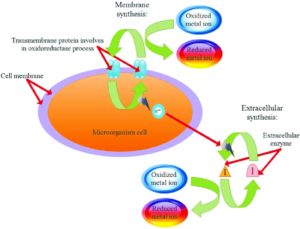Role of Nanotechnology in science field
Nanotechnology plays a crucial role across various science fields due to its ability to manipulate and control materials at the nanoscale, which is on the order of nanometers (10-9 meters). This field has led to significant advancements and innovations in various areas of science. Here are some key roles of nanotechnology in different science fields:
Materials Science:
Nanomaterials are materials that are designed, engineered, or manipulated at the nanoscale, typically ranging from 1 to 100 nanometers in size. This scale is on the order of atoms and molecules, leading to unique properties and behaviors compared to bulk materials. Nanomaterials play a crucial role in various scientific and technological applications due to their enhanced physical, chemical, mechanical, electrical, and optical properties. Here are some key aspects and types of nanomaterials:
Size and Structure:
Nanoparticles: These are solid particles with nanoscale dimensions in at least one dimension. Nanoparticles can be metallic (e.g., gold, silver), semiconductor (e.g., quantum dots), or insulating (e.g., silica nanoparticles).
Nanotubes: These are cylindrical structures with nanoscale diameters, such as carbon nanotubes (CNTs) and nanotubes made from other materials like boron nitride or metal oxides.
Nanowires: These are nanoscale wires or rods, often made of metals or semiconductors, used in electronics and sensors.
Properties of Nanomaterials:
Size-Dependent Properties: Nanomaterials exhibit size-dependent properties due to quantum confinement effects, surface effects, and increased surface-to-volume ratios. These properties can include enhanced mechanical strength, catalytic activity, optical properties (e.g., plasmonic effects), and electrical conductivity.
Surface Area: Nanomaterials have high surface area-to-volume ratios, making them suitable for applications like catalysis, sensors, and energy storage devices where surface interactions are crucial.
Types of Nanomaterials:
Carbon-Based Nanomaterials: These include carbon nanotubes (CNTs), graphene, fullerenes, and carbon nanofibers. They have exceptional mechanical strength, electrical conductivity, and thermal properties, making them valuable in electronics, composites, energy storage, and biomedical applications.
Metal and Metal Oxide Nanoparticles: Metals like gold, silver, iron, and metal oxides such as titanium dioxide (TiO2) and zinc oxide (ZnO) are widely used in nanomaterials for catalysis, electronics, sensors, and biomedical applications.
Semiconductor Nanomaterials: These include quantum dots (QDs) and nanowires made from materials like silicon, gallium arsenide (GaAs), and indium phosphide (InP). Semiconductor nanomaterials find applications in optoelectronics, solar cells, and quantum computing.
Composite Nanomaterials: These are combinations of different nanomaterials or nanomaterials embedded in matrices (polymer, ceramic, metal) to achieve synergistic properties. For example, carbon nanotube composites can enhance mechanical strength and conductivity in materials.
Organic and Hybrid Nanomaterials: These include organic nanoparticles, dendrimers, and hybrid materials combining organic and inorganic components. They are used in drug delivery, imaging, sensors, and nanoelectronics.
Applications of Nanomaterials:
Electronics and Optoelectronics: Nanomaterials are used in electronic devices (transistors, memory storage), flexible electronics, displays, LEDs, photodetectors, and photovoltaics.
Biomedical and Healthcare: Nanomaterials play a vital role in drug delivery systems, imaging agents (contrast agents for MRI, fluorescent probes), biosensors, tissue engineering scaffolds, and cancer therapy (e.g., hyperthermia using magnetic nanoparticles).
Energy and Environment: Nanomaterials are used in energy storage devices (batteries, supercapacitors), catalysis for clean energy production (fuel cells, solar cells), water purification, pollution control, and environmental sensors.
Aerospace and Automotive: Nanomaterials contribute to lightweight and high-strength composites, improved fuel efficiency, corrosion resistance, and thermal management in aerospace and automotive applications.
Consumer Products: Nanomaterials are found in coatings (e.g., self-cleaning surfaces, scratch-resistant coatings), textiles (e.g., stain-resistant fabrics, UV-blocking clothing), and cosmetics (e.g., sunscreens with nano-sized particles for better UV protection).
Overall, nanomaterials offer a wide range of possibilities and are driving innovations across industries by leveraging their unique properties and functionalities at the nanoscale. However, it’s also important to consider the environmental and health implications of nanomaterials, ensuring responsible development and safe use in various applications.
Nanofabrication: Nanotechnology has advanced fabrication techniques, such as molecular self-assembly and nanostructuring, leading to the development of miniaturized and more efficient devices.
Electronics and Photonics:
Nanoelectronics: Nanotechnology has contributed to the miniaturization of electronic components, leading to faster, smaller, and more energy-efficient devices. Nanoscale transistors, memory devices, and sensors are examples of nanoelectronic applications.
Nanophotonics: Nanotechnology has enabled the development of nanoscale optical components and devices, including photonic crystals, nanoscale lasers, and optical sensors, with applications in telecommunications, imaging, and sensing.
Medicine and Healthcare:
Nanomedicine: Nanotechnology has transformed medicine by offering targeted drug delivery systems, imaging techniques, and diagnostic tools at the molecular and cellular levels. Nanoparticles can deliver drugs specifically to diseased cells, reducing side effects and improving treatment efficacy.
Biosensors: Nanotechnology-based biosensors enable rapid and sensitive detection of biomolecules, pathogens, and environmental contaminants, contributing to healthcare diagnostics, food safety, and environmental monitoring.
Energy and Environment:
Nanoscale Energy Materials: Nanotechnology has led to the development of efficient energy storage devices (e.g., batteries, supercapacitors) and energy conversion technologies (e.g., solar cells, fuel cells) by optimizing materials at the nanoscale for enhanced performance and durability.
Environmental Remediation: Nanotechnology offers solutions for water purification, air filtration, and remediation of contaminated sites through the development of nanomaterial-based filters, catalysts, and adsorbents.
Agriculture and Food Science:
Nanopesticides: Nanotechnology has potential applications in agriculture through the development of nanopesticides for targeted delivery and controlled release of agrochemicals, reducing environmental impact and improving crop yields.
Food Safety and Packaging: Nanotechnology plays a role in food safety by providing antimicrobial coatings for packaging materials, sensors for detecting food contaminants, and nanoscale delivery systems for food additives and nutrients.
Environmental Monitoring and Sensing:
Nanosensors: Nanotechnology enables the development of highly sensitive and selective sensors for detecting pollutants, gases, toxins, and biological agents in environmental monitoring, industrial safety, and healthcare applications.
These examples illustrate the diverse and impactful roles of nanotechnology in advancing scientific knowledge, technological innovation, and addressing global challenges across multiple disciplines. Continued research and development in nanotechnology hold great promise for future breakthroughs and applications in various science fields.
Nanosensors are a type of sensor technology that operates at the nanoscale, utilizing nanomaterials or nanotechnology principles to detect and respond to specific signals or stimuli. These sensors are designed to be highly sensitive, selective, and often have rapid response times due to their nanoscale features. Nanosensors find applications in various fields, including healthcare, environmental monitoring, food safety, and industrial processes. Here are key aspects and examples of nanosensors:
Working Principles:
Transduction Mechanisms: Nanosensors utilize different transduction mechanisms to convert a physical, chemical, or biological signal into a measurable output, such as electrical, optical, or mechanical signals.
Recognition Elements: Nanosensors often incorporate specific recognition elements, such as antibodies, aptamers, enzymes, or functionalized nanomaterials, which interact selectively with target molecules or analytes.
Types of Nanosensors:
Chemical Nanosensors: These detect and quantify chemical species such as gases, ions, and organic compounds. Examples include gas sensors for environmental monitoring (e.g., detecting pollutants), ion-selective electrodes for measuring ion concentrations in solutions, and chemical sensors for detecting biomolecules in biological samples.
Biosensors: Biosensors are nanosensors specifically designed for detecting biological molecules or biomarkers. They find applications in healthcare for diagnostics (e.g., glucose sensors for diabetes monitoring), biomolecular detection (e.g., DNA sensors), and bioprocess monitoring (e.g., enzyme activity sensors).
Physical Nanosensors: These measure physical parameters such as temperature, pressure, humidity, and mechanical strain at the nanoscale. Examples include nanoscale temperature sensors for nanoelectronics and nanomechanical sensors for detecting tiny forces or displacements.
Optical Nanosensors: Optical nanosensors rely on changes in light properties (e.g., absorbance, fluorescence, refractive index) to detect analytes. Quantum dots, plasmonic nanoparticles, and fluorescent nanomaterials are commonly used in optical nanosensors for sensitive detection and imaging.
Environmental Nanosensors: These are designed for monitoring environmental parameters such as air quality (detecting pollutants like gases and particulate matter), water quality (measuring pH, heavy metals, or contaminants), and soil conditions (e.g., nutrient levels, pollutants).
Nanoelectronic Sensors: Nanoelectronic sensors utilize nanomaterials like carbon nanotubes, graphene, or semiconductor nanoparticles to detect electrical or electronic changes in response to analyte interactions. They are used in gas sensing, chemical sensing, and biomedical applications.
Smart Nanosensors: These are integrated nanosensor systems that combine sensing elements with microelectronics, wireless communication, and data processing capabilities. Smart nanosensors can provide real-time monitoring, remote sensing, and autonomous operation in complex environments.
Applications of Nanosensors:
Healthcare and Biomedical: Nanosensors play a vital role in medical diagnostics (e.g., glucose monitoring, biomarker detection), drug delivery systems (monitoring drug release), point-of-care testing, and bioimaging (e.g., fluorescent probes for cellular imaging).
Environmental Monitoring: Nanosensors are used for air quality monitoring (detecting pollutants like NOx, CO, and VOCs), water quality assessment (measuring contaminants), and soil monitoring (nutrient levels, pesticides).
Food Safety and Agriculture: Nanosensors contribute to detecting food contaminants (e.g., pathogens, pesticides), monitoring food freshness and quality, and optimizing agricultural practices (e.g., soil nutrient sensing, crop monitoring).
Industrial Processes: Nanosensors are employed in industrial settings for process monitoring (e.g., detecting leaks, measuring chemical concentrations), quality control, and ensuring safety in hazardous environments.
Consumer Electronics: Nanosensors are integrated into consumer electronics for touchscreens, motion sensing (accelerometers), environmental sensors in smartphones, and wearable devices for fitness tracking and health monitoring.
Challenges and Considerations:
Sensitivity and Specificity: Nanosensors must exhibit high sensitivity and specificity to target analytes while minimizing interference from background signals.
Stability and Reliability: Ensuring the stability and reliability of nanosensors over time and under various conditions is crucial for their practical applications.
Cost and Scalability: Developing cost-effective fabrication methods and scalable production processes for nanosensors is essential for widespread adoption and commercialization.
Ethical and Safety Considerations: Addressing ethical, privacy, and safety concerns related to the use of nanomaterials and nanotechnology in sensor applications is important for responsible deployment and regulatory compliance.
In summary, nanosensors represent a cutting-edge technology with diverse applications across industries, offering enhanced performance, miniaturization, and sensitivity compared to conventional sensors. Continued research and development in nanosensor design, fabrication techniques, and integration with smart systems will further expand their capabilities and impact in addressing societal challenges and advancing technological innovations.
Related Posts

Microbial Synthesis of Nanoparticles
INTRODUCTION: Nanoparticles, which are demarcated as particles with as a minimum one measurement measuring hundred nanometres or fewer, have gained a lot of consideration because

Quality Education For All, Vision of Sustainable Bharat
A Case Study Of Unicorn Physics Wallah INTRODUCTION It was in news everywhere when India overtook the third place with 54 UNICORNS in 2021, this

The Power of Emotional Intelligence: Unlocking University Success – Geeta University
The Power of Emotional Intelligence: Unlocking University Success – Geeta University Emotional intelligence, often referred to as EQ, plays a vital role in achieving success
